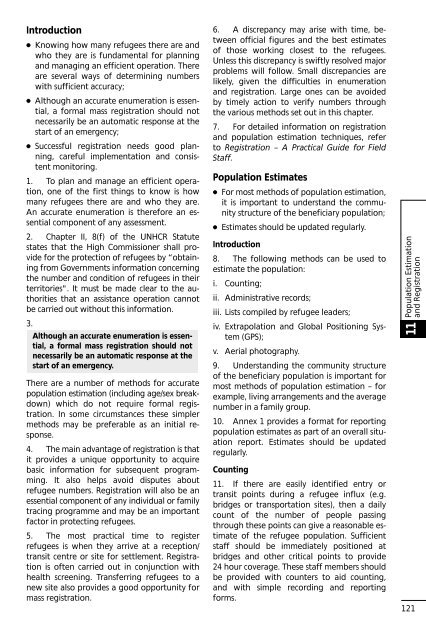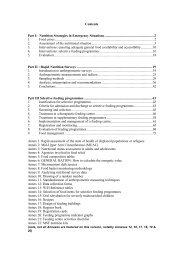UNHCR Handbook for Emergencies - UNHCR eCentre
UNHCR Handbook for Emergencies - UNHCR eCentre
UNHCR Handbook for Emergencies - UNHCR eCentre
You also want an ePaper? Increase the reach of your titles
YUMPU automatically turns print PDFs into web optimized ePapers that Google loves.
Introduction<br />
● Knowing how many refugees there are and<br />
who they are is fundamental <strong>for</strong> planning<br />
and managing an efficient operation. There<br />
are several ways of determining numbers<br />
with sufficient accuracy;<br />
● Although an accurate enumeration is essential,<br />
a <strong>for</strong>mal mass registration should not<br />
necessarily be an automatic response at the<br />
start of an emergency;<br />
● Successful registration needs good planning,<br />
careful implementation and consistent<br />
monitoring.<br />
1. To plan and manage an efficient operation,<br />
one of the first things to know is how<br />
many refugees there are and who they are.<br />
An accurate enumeration is there<strong>for</strong>e an essential<br />
component of any assessment.<br />
2. Chapter II, 8(f) of the <strong>UNHCR</strong> Statute<br />
states that the High Commissioner shall provide<br />
<strong>for</strong> the protection of refugees by “obtaining<br />
from Governments in<strong>for</strong>mation concerning<br />
the number and condition of refugees in their<br />
territories". It must be made clear to the authorities<br />
that an assistance operation cannot<br />
be carried out without this in<strong>for</strong>mation.<br />
3.<br />
Although an accurate enumeration is essential,<br />
a <strong>for</strong>mal mass registration should not<br />
necessarily be an automatic response at the<br />
start of an emergency.<br />
There are a number of methods <strong>for</strong> accurate<br />
population estimation (including age/sex breakdown)<br />
which do not require <strong>for</strong>mal registration.<br />
In some circumstances these simpler<br />
methods may be preferable as an initial response.<br />
4. The main advantage of registration is that<br />
it provides a unique opportunity to acquire<br />
basic in<strong>for</strong>mation <strong>for</strong> subsequent programming.<br />
It also helps avoid disputes about<br />
refugee numbers. Registration will also be an<br />
essential component of any individual or family<br />
tracing programme and may be an important<br />
factor in protecting refugees.<br />
5. The most practical time to register<br />
refugees is when they arrive at a reception/<br />
transit centre or site <strong>for</strong> settlement. Registration<br />
is often carried out in conjunction with<br />
health screening. Transferring refugees to a<br />
new site also provides a good opportunity <strong>for</strong><br />
mass registration.<br />
6. A discrepancy may arise with time, between<br />
official figures and the best estimates<br />
of those working closest to the refugees.<br />
Unless this discrepancy is swiftly resolved major<br />
problems will follow. Small discrepancies are<br />
likely, given the difficulties in enumeration<br />
and registration. Large ones can be avoided<br />
by timely action to verify numbers through<br />
the various methods set out in this chapter.<br />
7. For detailed in<strong>for</strong>mation on registration<br />
and population estimation techniques, refer<br />
to Registration – A Practical Guide <strong>for</strong> Field<br />
Staff.<br />
Population Estimates<br />
● For most methods of population estimation,<br />
it is important to understand the community<br />
structure of the beneficiary population;<br />
● Estimates should be updated regularly.<br />
Introduction<br />
8. The following methods can be used to<br />
estimate the population:<br />
i. Counting;<br />
ii. Administrative records;<br />
iii. Lists compiled by refugee leaders;<br />
iv. Extrapolation and Global Positioning System<br />
(GPS);<br />
v. Aerial photography.<br />
9. Understanding the community structure<br />
of the beneficiary population is important <strong>for</strong><br />
most methods of population estimation – <strong>for</strong><br />
example, living arrangements and the average<br />
number in a family group.<br />
10. Annex 1 provides a <strong>for</strong>mat <strong>for</strong> reporting<br />
population estimates as part of an overall situation<br />
report. Estimates should be updated<br />
regularly.<br />
Counting<br />
11. If there are easily identified entry or<br />
transit points during a refugee influx (e.g.<br />
bridges or transportation sites), then a daily<br />
count of the number of people passing<br />
through these points can give a reasonable estimate<br />
of the refugee population. Sufficient<br />
staff should be immediately positioned at<br />
bridges and other critical points to provide<br />
24 hour coverage. These staff members should<br />
be provided with counters to aid counting,<br />
and with simple recording and reporting<br />
<strong>for</strong>ms.<br />
Population Estimation<br />
and Registration<br />
11<br />
121



